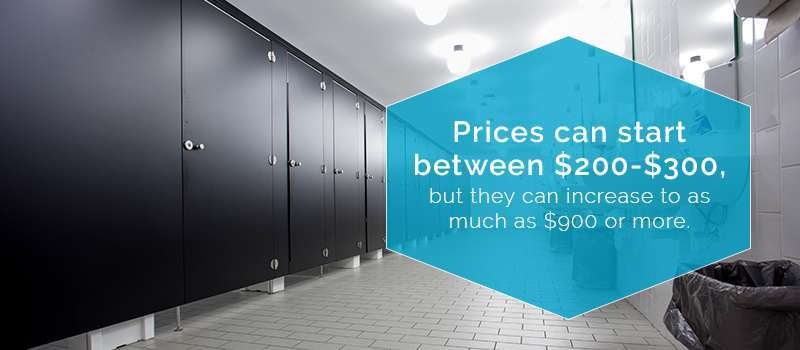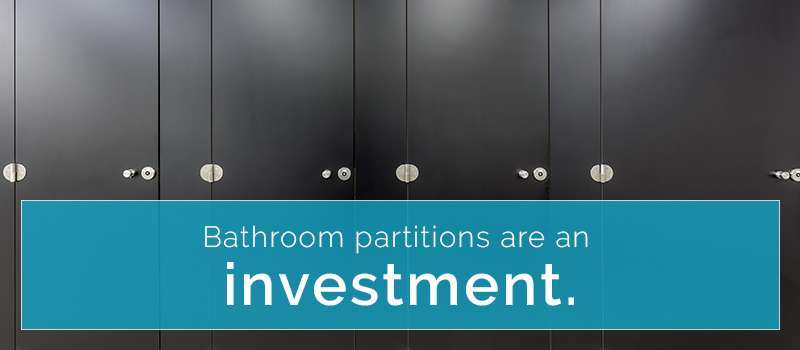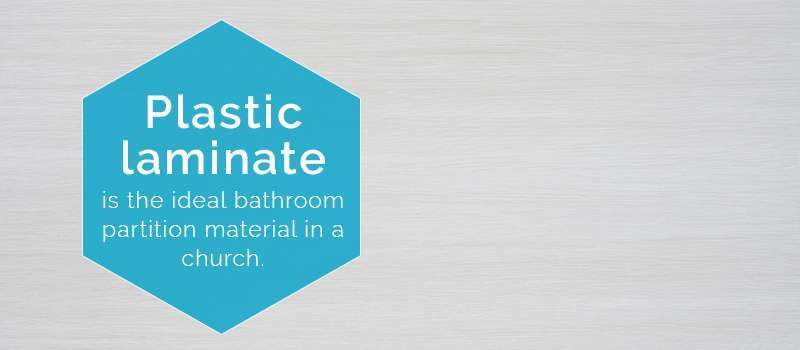The Most Popular Bathroom Partitions and How to Pick Them
What Are The Most Popular Bathroom Partitions?
- Powder Coated Steel
- Plastic Laminate
- Solid Plastic
- Phenolic Core
- Stainless Steel
Are you designing a new bathroom space for your restaurant, office, hotel or other business? Or are you project managing a commercial bathroom renovation for a restroom that needs a little sprucing up? If so, you’ve got a lot of design pieces to consider. What kind of tile are you going to lay on the floor? How many stalls will there be? How many sinks? How will all the elements be laid out?
These are all important questions, but there’s another question of equal importance that might not be one of the first things you think of: What are you building your bathroom partitions out of?
What’s the Best Bathroom Partition Material?
Did you know that there are five commonly used types of commercial bathroom partition materials to choose from? Each type of material has its own unique strengths and weaknesses. Each has its own advantages and each type of material is designed for certain things.
So what’s the best partition material to use when designing a new bathroom?
The short answer is that there is no “best” material. Every material has its own pros and cons, and every situation demands a unique solution.
To decide what type of bathroom partition you should install, there are several factors to consider. What type of building is your bathroom going to be in? Is it an office, a church, a school, a gym or something else entirely? How much traffic is it going to see? Are you interested in a more sophisticated feel, or are you purely interested in durability and function? How much wear-and-tear are they going to be subject to? How much money are you looking to spend? These are important questions to ask yourself when deciding.
To help you make your decision, let’s review the most popular bathroom partition materials.
1. Powder Coated Steel
Powder coated steel is one of the most commonly used partition materials.
Powder coated steel is made by taking a panel of honeycomb cardboard, which is an extremely lightweight and durable material, and covering it on either side with thick sheets of metal. The metal is covered with a colored powder that has then been baked into the metal.
The chief advantage of powder coated steel is that it’s almost always the most affordable option. Prices can start between $200-$300, although they can increase to as much as $900 or more, depending on the size and quantity you need to purchase. This material also usually comes with a warranty.
There can be a lack of variety with this type of material, as color options tend to be limited. Partitions made from powder coated steel also only offer a moderate level of protection from vandalism and graffiti. They are rust and corrosion resistant, but don’t always stand up to excessive amounts of water.
2. Plastic Laminate
The core of this material is particle board, which is then covered in a layer of laminate and a thin sheet of steel. This type of partition is essentially the next level up from the powder coated steel and would make a fine replacement if you’re about to remodel.
The advantage of this type of material is that it’s so popular, it’s available in an extensive variety of colors and patterns. It’s easily the most customizable material you can use for a partition. It’s also an affordable option. The typical warranty for these kinds of partitions is a few years.
Plastic laminated partitions are great for many spaces, although if you’re hoping for longevity, using them for shower rooms, heavily-used pool bathrooms or other water-heavy spaces may not make them the most economical choice. The material can’t be used anywhere it might be exposed to large amounts of water, or even high levels of humidity. Another material option to consider in wet environment is solid plastic.
3. Solid Plastic
Solid plastic is the next material level up from plastic laminate. When a partition is made from solid plastic, that means it’s made from solid panels of polymer plastic, typically an inch thick. Solid plastic partitions are known for being extremely durable and extremely resistant to just about anything that might threaten to damage them, such as mold, moisture, common cleaners and rust
The major advantage of these partitions is how durable they are. They can withstand almost any kind of environment — dry or wet, hot or cold. They’re easy to clean and can handle lots of wear-and-tear. Warranties vary, but when you purchase solid plastic partitions from us, we offer you a 15-year warranty — they’ll last a long time.
If you’re looking for a tough, long-lasting partition, the financial investment for a solid plastic partition may be worth it. The price can start around $400, but can go much higher depending on size and quantity. Even though there can be a higher price point, you’re getting what you pay for if you choose solid plastic as your partition material. These partitions will last through just about anything.
In addition to these advantages, plastic partitions also come in special models specifically designed to be scratch and graffiti resistant. These models can be slightly more expensive, but they’re a good investment. They’ll last for years without needing to be replaced.
4. Phenolic Core
This material is made from layers of paper pressed together and soaked in a phenolic resin coating. It’s a synthetic polymer, and is another type of material that’s extremely resilient and likely to hold up well under tough circumstances.
The major advantage of phenolic core is its durability and long lifespan. Partitions made of this material are very resistant to impact, meaning vandalism will be more difficult. Since they do fine with water, this means that they’re easy to clean and suitable for a wide variety of environments. They’re also bacteria and corrosion resistant.
Because this material makes your partitions so tough, these models run a little bit more expensive than even the plastic partitions. You might want to consider phenolic if your bathroom remodel is for a high-traffic environment, such as an amusement park.
5. Stainless Steel
Partitions made from stainless steel are the top-of-the-line. Stainless steel provides an undeniably classy, more sophisticated feel that the other partitions may not achieve, especially if your remodel is for an office or business environment. Partitions made from stainless steel can be smooth or engraved with patterns.
The first advantage is the aesthetic appeal. These partitions will look high-end and sophisticated, while being extremely durable, as well as rust and scratch resistant. They last a very long time and can withstand any kind of environment that the plastic partitions can.
While a basic stainless steel install will cost about twice as much as powder coated steel, it’s important to remember that bathroom partitions are an investment. If looks and durability are important to you, you can’t go wrong with stainless steel. They’ll serve you for years and years to come.
Which of the Most Popular Bathroom Partition Materials Should You Use?
After reviewing all the materials above, and before you take any bathroom remodel steps, you should first consider the application and practicality of your remodel situation. What materials are best suited for certain kinds of environments and buildings? What makes one type of material better suited to a church than a school?
There are four main questions you need to ask yourself when deciding what material will work best for your building project:
- What level of traffic will these bathrooms be subject to?
- What type of environment will these bathrooms be in? (High humidity, water contact, etc.)
- What level of potential vandalism will they face?
- How important are aesthetic and customization in your new bathroom?
Let’s look at different types of spaces separately and examine your options.
1. Schools
If you’re building a school bathroom, your main concern is likely to be potential damage to your partitions. School bathrooms will be used by hundreds of kids every day. Those stall partitions will be subject to vandalism, graffiti, water, scratches and everything else you can think of, in addition to the daily wear-and-tear any public restroom experiences.
You need bathroom partitions that can stand up to this use and more.
This narrows your options down to three choices — the solid plastic, phenolic core or the stainless steel.
Due to the high cost of the stainless steel and the phenolic core, the solid plastic is probably your best choice. Unless this is a school where aesthetic is an extremely important factor, solid plastic will likely serve best.
Plastic partitions are likely to withstand damage caused by students. They’re easy to clean, as they can be hosed down without fear of damage. They’re an affordable option too, making them more cost effective for the large number of bathrooms required throughout a school.
2. Churches
Churches typically don’t see quite the same amount of wear that school bathrooms do. The volume of people using them simply isn’t as high, and they typically aren’t being used five days of the week. Durability will still be an important factor, but they probably don’t need to be as heavy-duty as the partitions at a school.
Other factors you can consider are the age and style of the church building. Churches come in all shapes and sizes. Some are brand new buildings, while some can be over a century old. Some can be a hybrid of these two, with old and new sections melded together. Because of this, customizability is an important factor. You’ll want to match your bathroom partitions to whatever style the existing bathroom is.
These factors point to plastic laminate as the ideal bathroom partition material in a church.
Laminate is durable without being overly heavy-duty. It’s customizable. It’s cost effective for church congregations of every size. Laminate’s low defense against water shouldn’t pose a problem, since most church bathrooms aren’t exposed to large amounts of water, like a spa or gym might be.
3. Office Buildings
Here is another situation where your primary concern probably isn’t the amount of wear on your partitions. They’ll experience an average amount of damage, but not the same level of a high-school, middle school, hotel or bar. Your typical concerns are more likely to be aesthetics and matching the style of your bathroom to your office’s décor.
When it comes to deciding what material to use, you’re in luck. There isn’t really a wrong decision. Your decision will likely have a lot to do with your budget.
Powder-coated steel partitions will do the job just fine. If you want a little bit more custom look, then laminate will provide all the customization you could want. Solid plastic might be a bit of a drastic measure for the level of durability you’ll need, but it certainly wouldn’t hurt. If you have the budget and are interested in adding a more sophisticated feel to your restroom, then you’ll do well with stainless steel.
4. Gyms
Gyms — or similar restrooms like health clubs, recreation centers and pools — all are going to be high-traffic bathrooms subjected to significant amounts of water and high levels of humidity.
Your best choice in a gym environment are bathroom partitions made from plastic. This material can easily withstand almost any damage that might come from the intense volume of traffic these restrooms face. Equally as important for these types of restrooms, plastic partitions are highly water resistant. For restrooms near pools and gyms, this is of critical importance. For this kind of durable resistance, the plastic partitions are almost certainly the right decision.
The phenolic core partition is a viable option as well due to its highly water-resistant nature. Stainless steel is also an option, if budgets allow and if aesthetic appeal is important to your situation. Both of these partition materials are difficult to damage and will last for years to come.
The advantage of the plastic over the phenolic core or the steel is that the plastic is lower maintenance, and is thus more practical for the high volume of traffic these restrooms will receive.
5. Restaurants, Hotels and Stores
This category is a little bit trickier, since there isn’t a simple best answer. It depends on many factors. How much traffic will there be? How important is aesthetic and customization?
Depending on your answers to these questions, the right choice for partition materials could be any of the options discussed here. If they won’t get that much traffic and looks are not extremely important, there’s no reason powder coated steel wouldn’t work well. Need a more of a custom look? Laminate is the best option. Going to be dealing with a lot of wear-and-tear? Stick to plastic. Looking for a classy vibe? Stainless steel will work best.
Ready to Buy Partitions for Your Next Bathroom Project?
Have you decided what type of material is best for the bathroom your building and you’re ready to get started? If so, consider One Point Partitions today. We’re happy to show you samples and start planning your bathroom layout.
With over a decade of experience in this business, we’re one of the most popular bathroom partition dealers in the country. Our team of experts has helped design hundreds of bathrooms and we’re excited to help you design yours. Be sure to check out our available products and contact us when you’re ready to get started on that new bathroom project.




